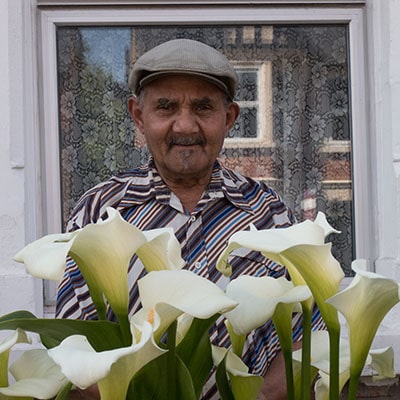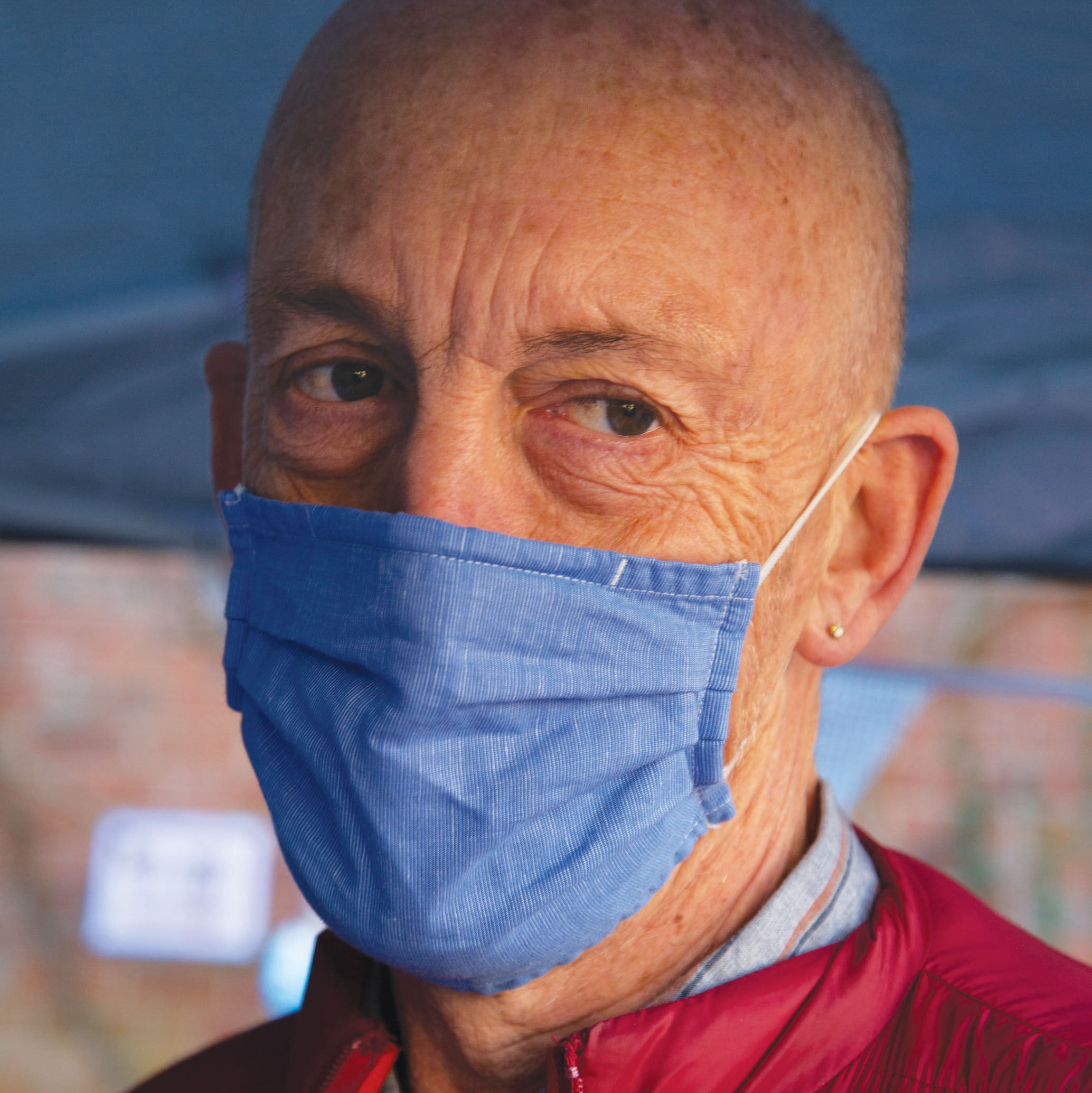The garden at Kelmscott Manor
I have visited Kelmscott Manor, the country home of William Morris and family close to the Thames in rural west Oxfordshire, quite a few times over the past 40 odd years. It is always a delight, even on the summer boat trip up from Oxford in 2019 when it poured with rain the entire day. But the trip out for Lord Muck’s seventyth birthday was a particular delight, both for the company and for the time to explore the garden at leisure. In the past I have tended to focus on the house, its history, and Morrisian associations, including the many items in it so closely connected with them, portraits by Rossetti, settle, bed, tapestries and the sense of absorbing just how they lived in that collection of rooms, corridors, attics, nooks and crannies that go make up that most romantic of houses. I didn’t miss any of this on this visit either, but the weather and the season encouraged a more detailed exploration of the garden too. My previous blog a couple of months ago on Morris and plants and their uses both in dyeing and as inspiration for his many designs, aroused my interest in ‘Morris the gardener’. As Fiona MacCarthy put it despite not being a keen gardener himself he had ”…a deep appreciation of a garden’s possibilities”. So a visit to the Manor where there is a glorious setting and plenty of opportunity for practical application, was an opportunity to test this.
There is in fact a book called The gardens of William Morris (Hamilton, Hart & Simmons 1998) with a very fetching painting of Kelmscott Manor set in its garden by the Morris’s friend Marie Stillman on the front cover. It is very good on the principles of the Morrisian garden, if we are to believe such a thing exists, connecting it with the distinctive natural character of a place, the importance of the thread of indigenous flora in Morris’s artistic work, and the idea that Morris’s ideal garden contained the essence of the man and his history; ”From his boyhood reading came chivalric scenes and romantic images of knights and ladies in vine-covered bowers. From studying Gerard’s sixteenth century Herball with its woodblock drawings of plants, he retained the picture of an early garden all cruciform paths and neat raised beds.” The authors are bold enough to set our the principles of Morris’s garden design. They are pretty timeless and make a lot of sense. Basically: unify house and garden; enclose the garden with trees, hedges or natural looking fences; preserve local identity; plant simple flowers; eschew fashion; integrate existing trees; make it productive; and, include places for recreation and relaxation. I’d settle for that in any garden of mine.
So does Kelmscott Manor’s garden measure up? It certainly starts off with a number of significant advantages; beautiful house and out buildings made from old stone, those outbuildings including a dovecote, privvy and various barns allow for walls and hedges to seem like the natural order of things, a significant walled garden, some ancient and impressive trees and the space to allow them to thrive rather than feel constrained or too dominant of a small space, and a certain solitude in the flat, reedy landscape that the house is set in. 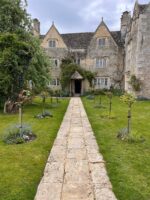 The entrance, through a relatively small doorway in the wall leads up to the front door along a flagstone path flanked with standard roses – a view familiar to anyone who has seen a copy of News from Nowhere. That entrance and the layout of the front garden certainly met with Morris’s approval, approaching his ideal, with straight paths and separate ‘rooms’ bounded by old yew hedges. It didn’t take long for Morris to integrate his love of Iceland into the garden, taking his shears to the yew hedge under the gable of the tapestry room and recreating it into a topiary dragon which he named Fafnir after the dragon in The story of Sigurd the Volsung (1876) .
The entrance, through a relatively small doorway in the wall leads up to the front door along a flagstone path flanked with standard roses – a view familiar to anyone who has seen a copy of News from Nowhere. That entrance and the layout of the front garden certainly met with Morris’s approval, approaching his ideal, with straight paths and separate ‘rooms’ bounded by old yew hedges. It didn’t take long for Morris to integrate his love of Iceland into the garden, taking his shears to the yew hedge under the gable of the tapestry room and recreating it into a topiary dragon which he named Fafnir after the dragon in The story of Sigurd the Volsung (1876) . It is still there, breathing fire.
It is still there, breathing fire.
Beyond the formal garden, the area of orchard and meadow leading down to a stream has ash, elm, elder, poplar, and willow along with hawthorn hedging and apple in blossom. Bird life, something Morris cherished and is reflected in his designs – think ‘Strawberry thief’, is in abundance, though the ‘bird apps’ of my companions seemed to be dominated by rooks. Noisy birds! As for the fruit and veg, well the Morris household table was well known for its productive kitchen garden, and in season there were cherries, strawberries, raspberries, gooseberries apples and plums. The modern tea room (in one of the airy stone barns) maintains the tradition, serving ‘apples quinces, mulberries and damsons’ from the garden. It isn’t hard to see where the mulberries come from. 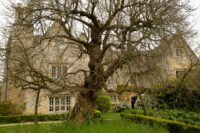 The tree is huge and like many of its species is held together with ropes, props, and ties, to minimise the chances of falling branches killing the visitors.
The tree is huge and like many of its species is held together with ropes, props, and ties, to minimise the chances of falling branches killing the visitors.
April is a little too early – even with the remarkably warm and wet winter we have endured, to see the main flower beds in their full glory, though honesty, cammasia, and the grey of cardoon foliage – grey was actually Morris’s favourite colour – gave a hint of pleasures to come, and the planting indicated considerable thought as did the fading cowslips and may blossom in the more informal spaces which lit up the Spring. 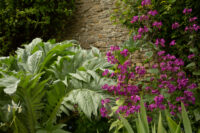 Perhaps the full enjoyment of the garden requires another visit – nothing wrong with seasons. In News from Nowhere the visitors arrive at ‘the old house’ at the end of their up-river journey, in June. As they raised the latch of the door in the wall, ‘My companion gave a sigh of pleased surprise and enjoyment; nor did I wonder, for the garden between the wall and the house was redolent of the June flowers and the roses were rolling over one another with that delicious superabundance of small well-tended gardens which at first sight takes away all thought from the beholder save that of beauty.’ Does Kelmscott today match up to this imaginary space so closely modelled on the 19 century home Morris so cherished? One hundred and fifty odd years afer he first fell in love with it, the answer has to be, yes.
Perhaps the full enjoyment of the garden requires another visit – nothing wrong with seasons. In News from Nowhere the visitors arrive at ‘the old house’ at the end of their up-river journey, in June. As they raised the latch of the door in the wall, ‘My companion gave a sigh of pleased surprise and enjoyment; nor did I wonder, for the garden between the wall and the house was redolent of the June flowers and the roses were rolling over one another with that delicious superabundance of small well-tended gardens which at first sight takes away all thought from the beholder save that of beauty.’ Does Kelmscott today match up to this imaginary space so closely modelled on the 19 century home Morris so cherished? One hundred and fifty odd years afer he first fell in love with it, the answer has to be, yes.
